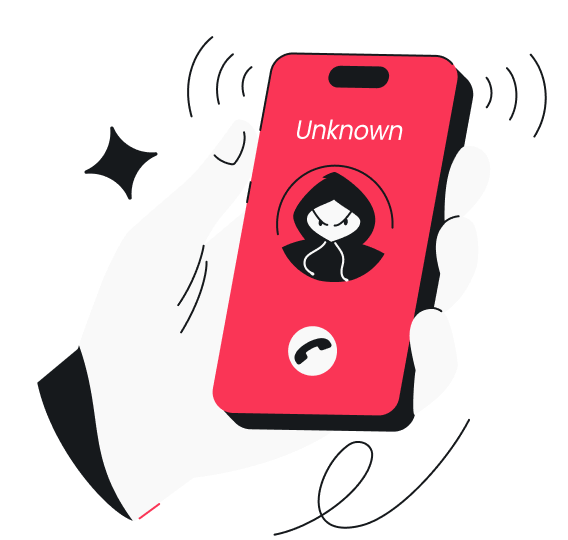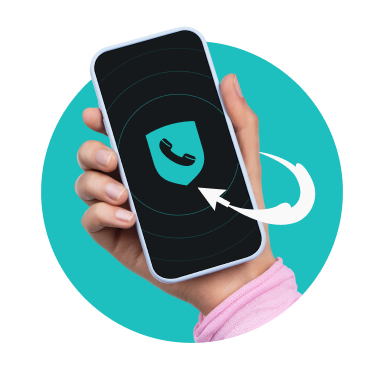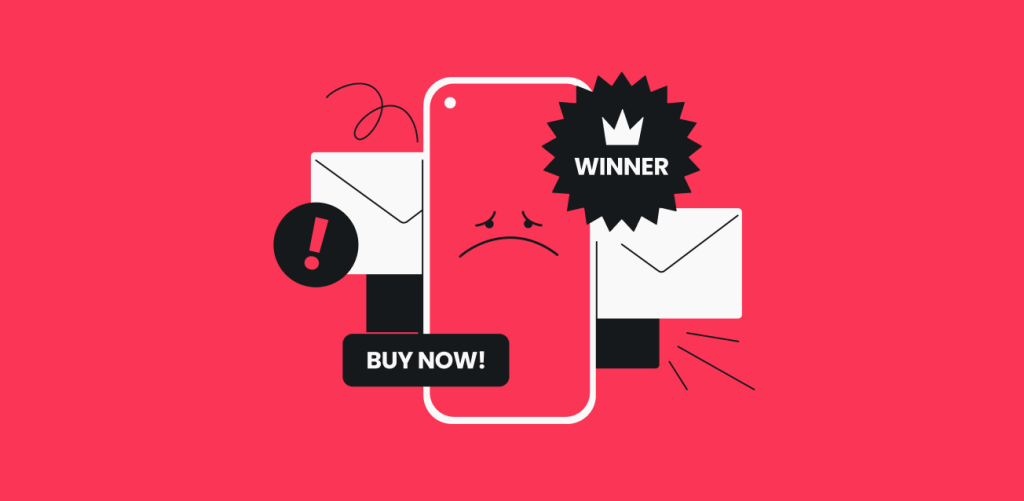A “Potential Spam” call is usually labeled as such because your mobile carrier has it flagged due to its unknown or suspicious origin.
You might not think answering these calls — whether you pick them up by mistake or out of curiosity — is a big deal. However, it’s wise not to overlook their risks, as engaging with these calls could open the door to all sorts of threats.
Read on to learn more about the risks of potential spam calls and how to effectively stop them.
What does “Potential Spam” mean?
Your mobile service provider may label a call as “Potential Spam” if the number has a suspicious source or can’t be verified. Depending on your carrier and the nature of the call, it might also pop up on your screen as “Spam Risk,” “Scam Likely,” “Spam Likely,” “Potential Fraud,” or “Robocaller.”
Each mobile carrier has its own way of identifying these calls. Most rely on machine learning algorithms that take into account:
- Caller behavior analysis: unusual calling patterns, such as high call volumes in a short span or calls to multiple numbers in rapid succession, are key indicators of potential spam activity;
- User feedback: numbers that receive multiple spam reports from users are likely to be flagged;
- Spoofing detection: spoofed calls — where callers disguise their numbers to appear as trusted or local numbers — are frequently flagged as they’re commonly used in spam robocalls;
- External databases: carriers often cross-check numbers against third-party databases that track known spam numbers and potential threats;
- Caller ID reputation: phone numbers receive a reputation score based on factors like call patterns and geographic consistency, with lower scores indicating potential spam.
While calls labeled as “Potential Spam” are often accurately tagged, there are instances where legitimate ones may mistakenly get flagged. Take area code 934 — calls from it often get flagged because scammers spoof them, though some calls actually come from genuine local residents. Conversely, some spam calls might slip through undetected.
Rather than seeing these tags as a definitive verdict, consider them a heads-up to avoid answering such calls and a reminder of the risks involved.
What could happen if you answer a potential spam call?
Even with the “Potential Spam” label, you might still answer these calls by mistake — especially when you’re in a hurry or expecting an important call. Answering these potential spam calls can lead to several possible outcomes.
Exposure to scams and fraud
Engaging with potential spam calls can expose you to a range of scams, schemes, and fraud. These callers may impersonate trusted organizations like banks, utility companies, popular brands, or government agencies to trick you into sharing personal information such as passwords or credit card details. They could also record your voice to use in more schemes.
Falling for these scams can lead to severe consequences like stolen identity, hacked devices, or drained bank accounts. Even if you don’t disclose any information, staying on the line gives scammers the chance to manipulate or press you into revealing something sensitive. It may also give them insights into your habits or vulnerabilities that they could exploit.
Unauthorized charges or fees
While some scammers play the long game, others go straight for your wallet when you answer their calls. A common ploy is to trick you into paying for fake services like bogus tech support, premium upgrades, or unwanted subscriptions. Even when responding noncommittally or just staying on the call, you could unintentionally authorize charges to your phone bill, credit card, or other payment methods.
These charges are often recurring but small enough not to set off alarm bells. Canceling them also tends to be extremely difficult, requiring you to navigate complex systems or make additional calls. Some bad actors might even double down and charge extra fees for cancellation.
Compromised personal information
Your personal information is at significant risk when you answer potential spam calls, as it can be easily extracted. For example, cybercriminals may encourage you to download software under the pretense of fixing a ‘technical’ issue. If you follow through, your device could get infected with malware that tracks your online activities or steals your personal data. You even risk having your phone number put on the dark web, where it can be exploited further.
They might also try to fish for answers to security questions or other verification details. A well-used tactic involves bad actors posing as representatives from legitimate companies — asking you to confirm personal details like date of birth, bank account number, and security PIN (Personal Identification Number). If successful, they could gain access to and compromise your accounts.
Unwanted sales pitches or marketing
Answering a potential spam call can expose you to aggressive and relentless sales tactics. Even calls from market research companies like Dynata subject you to annoying survey questions.
And both fraudsters and actual sales agents may pressure you into buying products and services you don’t need or want. Often, these pitches are misleading, with plenty of overblown claims or missing crucial details that keep you from making an informed decision.
Even if you resist these offers, simply answering the call could lead to even more spam. Your number could be marked as an active lead and sold to other sales reps, spammers, and scammers — increasing the frequency of these calls. Annoyance aside, it makes it difficult to tell apart legitimate calls from spam ones, leaving you constantly on guard against potential spam.
How to stop potential spam calls on your phone
Unfortunately, no single measure can completely block all potential spam calls. However, you can take several steps to significantly reduce them. Let’s run through some of these methods below.
Use an alternative number
Surfshark’s alternative number gives you an alternative phone number to use in place of your regular one. Calls forward to your phone, and texts appear in the Surfshark app. This prevents your actual number from falling into the hands of spammers.
If your alternative number starts attracting too many spam calls, you can switch to a new one — available once a month.
Block individual numbers
While individually blocking potential spam calls can be troublesome and time-consuming, it’s a straightforward and reliable method to manage them.
Here’s how to block potential spam calls on Android:
- Open the Phone app on your Android.
- Find the potential spam number in your Call Log or Recent Calls.
- Tap on the number > More (three vertical dots) or Info, depending on your phone model.
- Select Block number or Block contact from the menu.
For iPhone users, follow these steps to block potential spam calls:
- Open the Phone app on your iPhone.
- Find the potential spam number in Recents.
- Tap the Info icon (i in a circle) next to the number.
- Scroll down and hit Block Caller.
- Confirm by tapping on Block Contact.
Use spam-blocking tools
There’s a wide variety of spam-blocking tools, both free and paid, available to help block potential spam calls. Some might work better than others, but none are perfect.
| Tools to block potential spam calls | Features |
|---|---|
| AT&T ActiveArmor for AT&T customers | Potential spam and fraud call blocking, nuisance call alerts, and spam text filtering. |
| Verizon Call Filter for Verizon customers | Potential spam call blocking, call screening, and personal block list. |
| Hiya | Potential spam call blocking, voicemail-to-text feature, and reverse phone lookup. |
| Truecaller | Potential spam call blocking, call screening assistant, and caller ID. |
| Robokiller | Potential spam call and text blocking, custom filters, and Answer Bots. |
| Nomorobo | Potential spam call blocking, SMS protection, and call screening. |
Silence unknown callers
Both Android and iPhone offer features that allow you to silence unknown callers. If a call comes in from a number not saved in your address book, your phone won’t ring. Instead, the call will go straight to voicemail. While this feature won’t block scammers from calling, it helps you avoid the risk of accidentally picking up a potential spam call.
This is how you silence unknown callers on Android:
- Open the Phone app and tap the three dots to open the menu.
- From the menu, select Settings.
- Scroll down to Block Numbers and tap on it.
- Toggle on Block Unknown Callers to enable the feature.
On iPhone, follow these steps:
- Open Settings.
- Scroll down to Phone and tap on it.
- Look for Silence Unknown Callers and tap on it.
- Toggle on the Silence Unknown Callers switch.
Remove your number from the data broker list
You can request data brokers, who scrape the internet for personal information and sell it, to wipe your data from their databases. If you’re in the US, you can also add your phone number to the Do Not Call registry run by the FTC (Federal Trade Commission) to opt out of telemarketing calls. However, keep in mind this won’t stop all spam calls and is limited to US territories.
A more effective solution is to use Incogni, a data broker removal service included with a Surfshark One+ subscription. Incogni scans for your personal information, including your phone number, and sends removal requests to data brokers on your behalf. By removing your number from these databases, you can significantly reduce the chances of receiving potential spam calls.
Play it smart — block potential spam calls before they cause trouble
While “Potential Spam” and other similar labels are extremely helpful for screening calls, they aren’t foolproof. Telemarketers, spammers, and other unscrupulous individuals are constantly looking for new ways to bypass these labels, making it easy to answer such calls unintentionally.
Your best bet to minimize the chances of picking up potential spam calls is to use a combination of strategies. Silence unknown callers on your phone, block suspicious numbers, and remove your number from data brokers’ databases. Additionally, use an alternative number to keep your actual number private and reduce the risk of it falling into the wrong hands.
FAQ
Why am I getting so much potential spam?
You might get more potential spam calls than usual if your phone number has been leaked, shared, or added to marketing lists. A data breach could also be a cause. If you suspect your phone number and other personal information have been compromised, immediately secure your account and devices by changing passwords, updating security measures, and using Surfshark to encrypt your data.
What does “Scam Likely” mean?
“Scam Likely” means that the number calling you has been flagged by your carrier as probably coming from a scammer, spammer, or another unwanted source. The label serves as a warning to be cautious, allowing you to decide whether to risk answering the call.
Are “Potential Spam” calls always spam?
No, not all calls with the “Potential Spam” label are spam. Mobile carriers often flag these numbers based on patterns or reports using an automated screening process, but some calls from unknown or new numbers could be legitimate. That said, it’s wise to proceed cautiously, as these “Potential Spam” labels are generally accurate.
How is “Potential Spam” determined?
Each carrier uses a different method to determine potential spam. Most rely on machine learning algorithms that analyze call patterns, user feedback, third-party database entries, and more.




